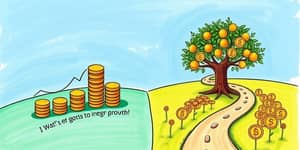
Investing can feel like navigating a stormy sea where every wave represents market volatility. Many dream of perfectly anticipating market highs and lows to maximize returns. However, decades of research reveal that relentless attempts to time the market often backfire, eroding wealth and causing emotional stress. Instead, disciplined strategies prevail, offering steadier progress toward long-term goals.
Below, we explore the definition, data, psychology, and expert advice that explain why market timing rarely works for most investors—and what you can do instead to build lasting financial security.
Market timing is the practice of attempting to enter or exit financial markets based on predictions about future price movements. Practitioners use technical charts, economic indicators, or sentiment signals to guess the best moments to buy low and sell high. In contrast, strategies like dollar-cost averaging builds wealth steadily focus on making regular investments at set intervals regardless of market conditions.
While timing promises outsized gains, it also carries risks of mistimed moves and missed opportunities that can significantly hinder portfolio growth.
The Efficient Market Hypothesis (EMH) asserts that asset prices fully incorporate all available information. Under its weak and semi-strong forms, neither technical charting nor fundamental analysis can consistently outperform the market without unique, inside knowledge. If prices already reflect every news headline, earning above-market returns through timing becomes virtually impossible for average investors.
EMH does not imply markets are perfectly rational, but it highlights how swiftly new data gets absorbed, leaving little room for predictable patterns to exploit.
Hard evidence underscores the challenges of timing. The S&P Dow Jones Indices SPIVA Scorecard shows that over 80% of active managers fail to beat their benchmark over 15-year periods. Their underperformance widens in turbulent markets, where wrong calls magnify losses.
Academic studies reinforce these findings. In "Trading Is Hazardous to Your Wealth," Barber and Odean demonstrated that frequent traders earn substantially lower returns than the market average. During volatile phases, the performance gap deepens as misguided trades and transaction costs take their toll.
Even professionals with cutting-edge resources struggle. Across decades, only a tiny fraction sustain superior performance, and success often hinges on fleeting market anomalies rather than repeatable timing rules.
Delaying investments to await an ideal entry point can be costlier than poor timing decisions. A Schwab study quantified this phenomenon: investors who waited for perfect conditions lost an average of $80,299 in potential growth, while even flawless timing would have netted just $13,796 in additional gains over the same period.
This comparison illustrates that missing just a few of the market’s best days can more severely impact returns than staying invested through short-term dips.
Over a 30-year stretch of the S&P 500, dollar-cost averaging outpaced average timing attempts. Investors who consistently invested each month saw a 254% return, whereas realistic timing efforts yielded between 227% and 252%. Only impossibly accurate forecasts—unattainable in reality—would have touched 289% returns.
Beyond numbers, DCA offers simplicity and emotional insulation, removing the guesswork that leads to procrastination or panic.
Human emotions often sabotage timing endeavors. During downturns, fear triggers premature selling; in rallies, greed compels buying at peaks. These reactive moves frequently miss subsequent rebounds, locking in losses and diminishing long-term compounding.
Procrastination looms large as well. The desire for certainty about the “best” moment to invest leads many to delay contributions indefinitely, sacrificing potential growth for the illusion of control.
While institutional titans sometimes extract value through advanced algorithms and vast data sets, these successes are rare and resource-intensive. Firms like Man Group employ complex, adaptive models and maintain constant innovation to maintain an edge. Such capabilities remain out of reach for most individual investors.
Even among pros, a small fraction sustains superior returns, and when they do, it often stems from specialized strategies rather than simple timing signals.
The GameStop and AMC saga underscored timing’s unpredictability. Retail investors who bought on viral hype saw dramatic, short-lived gains followed by steep losses when momentum evaporated. Hype-driven timing, far from delivering reliable profits, left many shaken and financially wounded.
Despite underwhelming long-term results, market timing remains a lucrative narrative in financial media and advisory circles. Firms advertise timing prowess to justify fees and showcase expertise, perpetuating myths that precision market entry is attainable and essential.
This marketing focus diverts attention from sound, research-backed approaches that emphasize planning, diversification, and discipline.
By adhering to a clear blueprint, investors sidestep the emotional roller coaster of timing and stay on track toward their objectives.
Market timing appeals to our instinct for quick gains, but extensive theory and data show that it rarely delivers. The unpredictability of information flow and human emotions makes consistent outperformance elusive. Instead, disciplined approaches like dollar-cost averaging and buy-and-hold investing harness the power of compounding, reduce stress, and foster enduring wealth accumulation.
Rather than chasing perfect timing, focus on building a robust plan, sticking to it through market cycles, and letting time and consistency work in your favor. In the long run, patience and persistence outperform precision.
References













